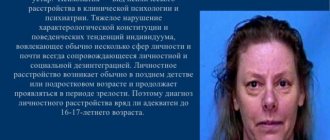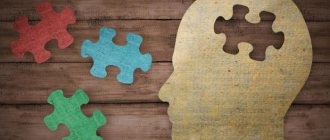Affective disorders, or mood disorders, are a general name for a group of mental disorders that are associated with a disturbance in the internal experience and external expression of a person's mood (affect).
The disorder is expressed in changes in the emotional sphere and mood: excessive elation (mania) or depression. Along with the mood, the individual’s activity level also changes. These conditions have a significant impact on human behavior and social function and can lead to maladjustment.
Causes
The exact causes leading to the development of affective disorders are currently unknown. Some researchers believe that the cause of this pathology lies in dysfunction of the pineal gland, hypothalamic-pituitary and limbic systems. Such disorders entail a disruption in the cyclical release of liberins and melatonin. As a result, the circadian rhythms of sleep and wakefulness, sexual activity, and nutrition are disrupted.
Affective disorders can also be caused by a genetic factor. It is known that approximately every second patient suffering from bipolar syndrome (a variant of affective disorder) had mood disorders in at least one of the parents. Geneticists have suggested that affective disorders may arise due to a mutation of a gene localized on the 11th chromosome. This gene is responsible for the synthesis of tyrosine hydroxylase, an enzyme that regulates the production of catecholamines by the adrenal glands.
Affective disorders, especially in the absence of adequate therapy, worsen the patient’s socialization, interfere with the establishment of friendly and family relationships, and reduce ability to work.
Psychosocial factors are often the cause of affective disorders. Long-term, both negative and positive stress causes overstrain of the nervous system, which is subsequently replaced by its exhaustion, which can lead to the formation of a depressive syndrome. The most severe stressors:
- loss of economic status;
- death of a close relative (child, parent, spouse);
- family quarrels.
Manifestation of affective syndrome
Pathology manifests itself in the form of negative emotional disorders, depressive states and mania. In some cases, accompanied by physiological disorders:
- difficulty breathing with a feeling of incomplete inspiration;
- heaviness in the chest;
- inhibition of movements and reactions;
- slowing down thought processes;
- loss of interest in things that were previously important to the patient.
Various types of depressive states manifested in pathology:
- manic-depressive psychoses;
- psychogenic depression;
- endogenous depressive states;
- depression of a somatic nature.
It is characterized by a sharp change, often occurring within one day. The period of attacks can last for several months and even years. Sleep disturbances are observed, appetite changes, and weight loss may occur.
Kinds
Depending on the prevailing symptoms, affective disorders are divided into several large groups:
- Depression. The most common cause of depressive disorder is a metabolic disorder of brain tissue. As a result, a state of extreme hopelessness and despondency develops. In the absence of specific therapy, this condition can last a long time. Often, at the height of depression, patients try to commit suicide.
- Dysthymia. One of the variants of depressive disorder, characterized by a milder course compared to depression. Characterized by a bad mood, increased anxiety every day.
- Bipolar disorder. The outdated name is manic-depressive syndrome, as it consists of two alternating phases, depressive and manic. In the depressive phase, the patient is in a depressed mood and apathy. The transition to the manic phase is manifested by increased mood, vigor and activity, often excessive. Some patients in the manic phase may experience delusions, aggression, and irritability. Bipolar disorders with mild symptoms are called cyclothymia.
- Anxiety disorders. Patients complain of feelings of fear and anxiety, internal restlessness. They are almost constantly in anticipation of impending disaster, tragedy, trouble. In severe cases, motor restlessness is noted, the feeling of anxiety gives way to a panic attack.
Affective disorders are divided into several groups
Diagnosis of affective disorders must necessarily include an examination of the patient by a neurologist and endocrinologist, since affective symptoms can be observed against the background of endocrine diseases, nervous system, and mental disorders.
Classification
In psychiatry, it is customary to distinguish several main forms of affective disorders, which differ in clinical picture. Exist:
- Depressive disorders. There is motor retardation, a tendency to negative thinking, an inability to experience a feeling of joy, and frequent mood swings.
- Manic disorders. They are characterized by high mood and mental arousal, high motor activity.
- Bipolar disorder or manic-depressive psychosis. There is an alternation of manic and depressive phases, which can replace each other or alternate with a normal mental state.
- Anxiety disorders. The person complains of the unreasonable appearance of fear, internal restlessness and anxiety. Such patients are almost always in a state of anticipation of approaching disaster, problems, troubles or tragedies. In severe cases, panic attacks develop.
Some affective mood disorders have their own classifications. Depression happens:
- clinical (major depressive disorder) - the symptoms are pronounced;
- low - the severity of symptoms is less intense;
- atypical - characteristic symptoms are complemented by emotional instability;
- psychotic - against the background of depression, various hallucinations occur;
- melancholic - a feeling of guilt develops;
- involutional - there is a decrease or significant impairment of motor functions;
- postnatal - characteristic symptoms appear when a woman gives birth to a child;
- recurrent disorder is the mildest form, characterized by a short duration of episodes of depression.
Separately, alcoholic depression and seasonal affective disorder are distinguished.
Manic state has two types:
- classic mania with a clear manifestation of the above symptoms;
- hypomania - symptoms are mild.
The types of course of manic-depressive psychosis include the following options:
- correctly intermittent - there is an orderly alternation of depression, mania and “light” intervals;
- incorrectly interleaved - there is a random alternation of phases;
- double - depression is immediately replaced by mania or vice versa, two such episodes are followed by a “bright” interval;
- circular - characterized by an orderly alternation of depression and mania, but there are no “light” intervals.
The duration of one episode can vary from one week to 2 years, and the average duration of the phase is several months. The “light” period ranges from 3 to 7 years.
There is a group of pathologies called “Chronic mood disorders”:
- dysthymia - symptoms are similar to clinical depression, and the symptoms are less intense but longer lasting;
- cyclothymia - a condition similar to bipolar disorder; there is an alternation of mild depression and hyperthymia;
- hyperthymia - expressed in an unreasonably elevated mood, a surge of strength and vigor, inadequate optimism and inflated self-esteem;
- hypothymia - characterized by persistent low mood, motor activity and emotionality;
- chronic anxiety;
- apathy or complete indifference to oneself, any events and the surrounding world.
Affective disorders
Signs
Each type of affective disorder has characteristic manifestations.
Main symptoms of depressive syndrome:
- lack of interest in the outside world;
- a state of prolonged sadness or melancholy;
- passivity, apathy;
- disturbances in concentration;
- feeling of worthlessness;
- sleep disorders;
- decreased appetite;
- deterioration in work ability;
- recurrent thoughts of suicide;
- deterioration in general health that cannot be explained during examination.
Bipolar disorder is characterized by:
- alternating phases of depression and mania;
- depressed mood during the depressive phase;
- during the manic period - recklessness, irritability, aggression, hallucinations and/or delusions.
Anxiety disorder has the following manifestations:
- heavy, obsessive thoughts;
- sleep disorders;
- decreased appetite;
- constant feeling of anxiety or fear;
- dyspnea;
- tachycardia;
- deterioration in concentration.
Bipolar affective disorder symptoms
This disease leads to a person’s complete loss of orientation in the world around him. Suicidal thoughts arise, careers end, and interpersonal relationships are destroyed. The disorder provokes life-threatening antisocial behavior.
The main symptom is a sudden change in mood. Depression gives way to euphoria. The change of cycles is chaotic. The duration of the phases cannot be determined. Sometimes the phases last for years. In the interval between attacks, there are no outward manifestations of the diagnosis and the patient feels completely healthy.
During depression, irritability, unmotivated anger, hopelessness and embarrassment are noted. In the euphoric stage, the patient may be prone to excessive spending or uncontrolled sexual relations.
The physiological state changes during different phases. During the manic stage, the patient feels a surge of strength, he is overly active, mobile, laughs often, speech becomes loud, and movements are impulsive.
The depressive stage is characterized by a sharp loss of strength. It becomes difficult for a person not only to move, but also to think. The duration of the depressive state is about two weeks. A repetition of the change of state occurs in most cases at least once every two years with the most ideal course of the disease.
The onset of the disease often occurs at the age of 20-30 years. Relatives may mistake the condition for a mental disorder. On average, the disease affects two out of a hundred people.
Features of the course in children and adolescents
The clinical picture of affective disorders in children and adolescents has distinctive features. Somatic and vegetative symptoms come to the fore. Signs of depression are:
- night terrors, including fear of the dark;
- problems falling asleep;
- pale skin;
- complaints of chest or abdominal pain;
- increased fatigue;
- a sharp decrease in appetite;
- moodiness;
- refusal to play with peers;
- slowness;
- learning difficulties.
A child's fear of the dark may be a sign of depressive affective disorder.
Manic states in children and adolescents also occur atypically. They are characterized by such signs as:
- increased cheerfulness;
- disinhibition;
- uncontrollability;
- sparkle of eyes;
- facial hyperemia;
- accelerated speech;
- constant laughter.
Health care
The choice of therapeutic course depends on the form of affective disorder, but in any case, patients are recommended to undergo outpatient treatment.
Patients are prescribed medications and psychotherapy sessions. The selection of drugs is carried out depending on the existing symptoms.
Treatment of depressive affective disorders
The main course of treatment includes taking selective and non-selective norepinephrine and serotonin uptake inhibitors.
Anxiety is relieved with:
- tricyclic antidepressants (Amitriptyline);
- selective inhibitors (Desipramine, Moclobemide, Ludiomil);
- tranquilizers (Diazepam, Lorazepam);
- neuroleptics (Aminazine, Haloperidol);
- non-selective monoamine oxidase inhibitors (Phenelzine, Nialamid, Iproniazid).
If there is an increased manifestation of melancholy, the following is prescribed:
- activating antidepressants (Nortriptyline, Anafranil, Protriptyline);
- non-selective monoamine oxidase inhibitors (Tranylcipramil);
- mood stabilizers (Finlepsin).
As an additional therapy, and also in case of ineffectiveness of drug treatment, electroconvulsive therapy is used.
Therapy for manic disorders
For the treatment of manic affective disorders, the following is used:
- mood stabilizers (Valproic acid, Carbamazepine, lithium preparations);
- neuroleptics (Chlorpromazine, Haloperidol, Zaprasidone).
Diagnostics
Diagnosis of affective disorders is carried out by a psychiatrist. It begins with a thorough history taking. For an in-depth study of the characteristics of mental activity, a medical and psychological examination may be prescribed.
Affective symptoms can be observed against the background of diseases:
- endocrine system (adrenogenital syndrome, hypothyroidism, thyrotoxicosis);
- nervous system (epilepsy, multiple sclerosis, brain tumors);
- mental disorders (schizophrenia, personality disorders, dementia).
That is why the diagnosis of affective disorders must necessarily include an examination of the patient by a neurologist and endocrinologist.
A type of affective syndrome
Diagnosis and successful initiation of treatment for affective syndrome is associated with a clear definition of the type of pathology.
Affective respiratory syndrome
The cause of the onset of pathology is a serious psycho-emotional stimulus. Accompanied by attacks of suffocation, panic attacks caused by the inability to continue normal breathing. It occurs quite rarely in adult patients, due to the acquisition of the skill to control one’s emotional state in the event of sudden moral and physical shocks.
Affectively delusional syndrome
A polymorphic psychotic disorder, often caused by schizophrenia. Manifestations in situations of diagnosing delirium and depression in patients suffering from various mental illnesses.
Affectively paranoid syndrome
Refers to exacerbations in recurrent and schizophrenia, acute paraphrenia and other psychiatric diagnoses. It manifests itself as symptoms of switching off consciousness in the form of coma, a state of stupor, hypochondria, and a constant feeling of guilt. Accompanied by movement disorders. Such as agitation, the speed of associations changes from complete slowdown to acceleration at the level of a “whirlwind of ideas.”
Affectively endogenous syndrome
Occurs with endogenous diagnoses, somatogenic mental pathologies. Accompanied by frequent changes in mood phases. The maximum duration of depressive periods lasts up to 6 months. During the period of remission, the pathology may be virtually invisible.
Affective respiratory syndrome in children
It is a frequent response of the body to sudden provoking situations in the form of holding or even stopping breathing. This manifestation also occurs in a situation of prolonged prolonged crying. May be accompanied by convulsions and loss of consciousness. In rare situations, it turns into epilepsy.
Affective instability syndrome
A state of emotional instability that is on the verge of normal. It is recommended to contact a specialist:
- in case of frequent breakdowns, the so-called “crazy”;
- affective outbursts;
- mood swings, often occurring at an unconscious level;
- low level behavior control.
Manifestations in most situations are associated with stressful conditions and weather changes. Unstable psychopathy borders on schizophrenia.
Affective depressive syndrome
Constantly depressed mood, energy and performance decrease, often patients are characterized by a refusal to control their appearance. Ungrooming appears. The mood does not improve in pleasant company. Thoughts about suicide often appear.
Affective pathology syndromes
Extremely diverse. A common symptom is a disturbance in the emotional state from a state of excessive joy to deep depression. If frequent mood swings are detected, it is recommended to consult a specialist for an accurate diagnosis.
Affectively hallucinatory syndrome
It is characterized by a combination of delusional and hallucinogenic disorders. Patients may experience visual and auditory hallucinations, decreased emotional status, or, conversely, increased agitation.
Treatment
The modern approach to the treatment of affective disorders is based on the simultaneous use of psychotherapeutic techniques and antidepressant medications. The first results of the treatment become noticeable after 1-2 weeks from its start. The patient and his relatives should be informed about the inadmissibility of spontaneous discontinuation of medications, even in the case of persistent improvement in mental health. Antidepressants can be discontinued only gradually, under the supervision of the attending physician.
Patients with affective disorders need the help of a psychotherapist
According to statistics, affective disorders of varying severity are observed in every fourth adult inhabitant of our planet. However, no more than 25% of patients receive specific treatment.
Affective personality disorder
Mood dysregulation affects many people throughout their lives. Impressionable citizens who are prone to heightened perception of what is happening suffer from such changes or are simply different. But not all cases of dysregulation are clinical.
The pathology is characterized by a noticeable and cyclical change of depression and euphoria. In the absence of treatment, such changes can occur even without additional provoking factors.
Patients suffering from affective personality disorder of any type are rarely able to control the change in their condition. To monitor the condition, observation by a specialist is required in order to promptly initiate drug treatment. Affective personality disorder without treatment leads to the destruction of the patient’s personality. It reduces the quality of life and destroys personal and social life. Periods of low and high energy destroy the body, often leading to suicidal tendencies.
Prevention
How to avoid the development of affective syndrome? For disorders caused by hereditary factors, the patient is advised to undergo periodic courses of therapy. This will allow you to maintain normal well-being and avoid relapses.
Preventive measures also include giving up existing bad habits, maintaining a rational daily routine that includes adequate sleep, alternating work and rest, allocating time for interesting activities, as well as maintaining trusting relationships with loved ones.
Delusions of poisoning and persecution
Such statements are characteristic of affective-paranoid syndrome. In this case, a person who has a thinking disorder is haunted by the idea that they are being watched or wanted to poison him. Moreover, all these actions are performed either by one person (creature) or by a group of persons. Patients are firmly convinced that they are being spied on, watched, and plotted to harm them. The persecutors in this case can be neighbors, relatives, friends or fictitious persons. Such patients become suspicious and withdrawn. They develop anxiety and the ability to adequately assess what is happening disappears.
The cause of this affective-delusional syndrome is mental illness of an endogenous nature, an intoxicating effect on the central nervous system, as well as degenerative neurotic pathologies. Factors predisposing to this condition include:
- psychoses caused by drug poisoning, alcohol addiction or paranoid schizophrenia;
- personal predisposition in the form of initial suspicion and distrust;
- negative experiences resulting from acts of humiliation, violence and psychological pressure.
Endogenous depression
All depressed mental states are divided into two groups. These are reactive and endogenous (circular). The first of these occur during unexpected stress. These are situations of separation, death of relatives or dangerous illness. Affective-endogenous syndrome becomes a consequence of a person’s internal disease. It is caused by a decrease in the level of hormones, including norepinephrine, dopamine and serotonin. An insufficient amount of them in the body leads to the appearance of ridiculous thoughts. A person begins to think that no one needs him in this world. At the same time, he develops a feeling of worthlessness, oppression and severe apathy.
The most vulnerable category for the development of affective-endogenous syndrome are people whose character contains such traits as integrity and responsibility, modesty and self-doubt, as well as a sense of duty. Melancholic and phlegmatic people often become hostage to this type of depression.
Affective-endogenous pathopsychological syndrome sometimes occurs unexpectedly. Sometimes against the backdrop of complete family well-being. The following manifestations are typical for this condition:
- mood swings during the day (sadness in the morning and lack of it in the evening);
- sleep disturbance in the form of early awakenings at 4-5 am;
- somatovegetative disturbances.
With endogenous depression, appetite sharply decreases or disappears completely. This leads to patients losing weight. Their skin turns pale, their face becomes sallow, and their mucous membranes lose moisture. Sexual and other instinctive impulses are suppressed. Women during depression are characterized by the development of amenorrhea, and men by a lack of libido. Doctors describe the presence of a triad characteristic of such patients, including constipation, dilated pupils and tachycardia.
With affective-endogenous syndrome, the secretory functions of the glands decrease, which leads to the absence of tears. Patients also complain of brittle nails and hair loss.
The most dangerous symptom of such a depressive state is the presence of suicidal thoughts. They are preceded by a reluctance to live, which is not accompanied by specific plans. This is the initial stage of suicidal ideation, which is passive.










